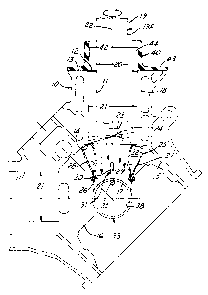Some of the information on this Web page has been provided by external sources. The Government of Canada is not responsible for the accuracy, reliability or currency of the information supplied by external sources. Users wishing to rely upon this information should consult directly with the source of the information. Content provided by external sources is not subject to official languages, privacy and accessibility requirements.
Any discrepancies in the text and image of the Claims and Abstract are due to differing posting times. Text of the Claims and Abstract are posted:
| (12) Patent: | (11) CA 2186659 |
|---|---|
| (54) English Title: | MASKING CYLINDER BORE EXTREMITIES FROM INTERNAL THERMAL SPRAYING |
| (54) French Title: | METHODE D'OBTURATION DES EXTREMITES DES CYLINDRES DESTINES A ETRE TRAITES PAR PROJECTION THERMIQUE |
| Status: | Term Expired - Post Grant Beyond Limit |
| (51) International Patent Classification (IPC): |
|
|---|---|
| (72) Inventors : |
|
| (73) Owners : |
|
| (71) Applicants : |
|
| (74) Agent: | MARKS & CLERK |
| (74) Associate agent: | |
| (45) Issued: | 2007-09-25 |
| (22) Filed Date: | 1996-09-27 |
| (41) Open to Public Inspection: | 1997-05-01 |
| Examination requested: | 2003-09-15 |
| Availability of licence: | N/A |
| Dedicated to the Public: | N/A |
| (25) Language of filing: | English |
| Patent Cooperation Treaty (PCT): | No |
|---|
| (30) Application Priority Data: | ||||||
|---|---|---|---|---|---|---|
|
Method of masking one or more extremities of a cylinder bore from internal thermal spraying, when using a rotary gun inserted from one end of the bore, by essentially the steps of: (a) supporting one or more inflatable mask members adjacent an end of the bore wall; (b) pressurizing the inflatable mask member to expand and annularly engage an end of the bore, the mask being constituted of an inflatable and collapsible air tight bag of heat resistant (fiberglass) cloth coated on opposite sides with a sacrificial heat resistant non-stick coating (silicone). The inflatable characteristic of the mask member allows it to conform to the periphery of the cylinder bore extremities, and allows it to be easily installed in or through the component in its deflated condition. The mask is reusable by being comprised of coating material that may gradually be sacrificed to heat and wear of the over spray.
La méthode d'obturation des extrémités des cylindres protège leur surface interne contre la projection thermique lorsqu'on insère un pistolet rotatif à l'une des extrémités. La méthode se déroule comme suit : (a) fixer un masque gonflable près de l'extrémité de l'ouverture; (b) gonfler le masque pour lui imprimer une pénétration annulaire dans l'ouverture, celui-ci étant fait d'un tissu étanche contractile résistant à la chaleur (fibre de verre), enduit de chaque côté d'un revêtement sacrificiel antiadhésif résistant à la chaleur (silicone). Le masque, en étant gonflable, s'adapte parfaitement à la courbure des extrémités du cylindre. Dégonflé, il est facile à mettre en place. Le masque peut être réutilisé, mais son revêtement sacrificiel disparaît lentement sous l'effet de la chaleur et de l'usure des pulvérisations répétées.
Note: Claims are shown in the official language in which they were submitted.
Note: Descriptions are shown in the official language in which they were submitted.

2024-08-01:As part of the Next Generation Patents (NGP) transition, the Canadian Patents Database (CPD) now contains a more detailed Event History, which replicates the Event Log of our new back-office solution.
Please note that "Inactive:" events refers to events no longer in use in our new back-office solution.
For a clearer understanding of the status of the application/patent presented on this page, the site Disclaimer , as well as the definitions for Patent , Event History , Maintenance Fee and Payment History should be consulted.
| Description | Date |
|---|---|
| Inactive: IPC deactivated | 2021-11-13 |
| Inactive: IPC deactivated | 2021-11-13 |
| Inactive: IPC deactivated | 2021-11-13 |
| Inactive: IPC assigned | 2021-09-02 |
| Inactive: IPC expired | 2018-01-01 |
| Inactive: Expired (new Act pat) | 2016-09-27 |
| Inactive: IPC expired | 2016-01-01 |
| Inactive: IPC expired | 2016-01-01 |
| Grant by Issuance | 2007-09-25 |
| Inactive: Cover page published | 2007-09-24 |
| Inactive: Final fee received | 2007-07-06 |
| Pre-grant | 2007-07-06 |
| Notice of Allowance is Issued | 2007-01-09 |
| Notice of Allowance is Issued | 2007-01-09 |
| Letter Sent | 2007-01-09 |
| Inactive: Approved for allowance (AFA) | 2006-12-04 |
| Inactive: IPC from MCD | 2006-03-12 |
| Inactive: IPC from MCD | 2006-03-12 |
| Inactive: IPC from MCD | 2006-03-12 |
| Inactive: IPC from MCD | 2006-03-12 |
| Amendment Received - Voluntary Amendment | 2004-03-11 |
| Inactive: Status info is complete as of Log entry date | 2003-10-15 |
| Letter Sent | 2003-10-15 |
| Inactive: Application prosecuted on TS as of Log entry date | 2003-10-15 |
| All Requirements for Examination Determined Compliant | 2003-09-15 |
| Request for Examination Requirements Determined Compliant | 2003-09-15 |
| Application Published (Open to Public Inspection) | 1997-05-01 |
There is no abandonment history.
The last payment was received on 2006-09-13
Note : If the full payment has not been received on or before the date indicated, a further fee may be required which may be one of the following
Please refer to the CIPO Patent Fees web page to see all current fee amounts.
Note: Records showing the ownership history in alphabetical order.
| Current Owners on Record |
|---|
| FORD MOTOR COMPANY OF CANADA, LIMITED |
| FORD MOTOR COMPANY OF CANADA, LIMITED |
| Past Owners on Record |
|---|
| DAVID A. DONOVAN |